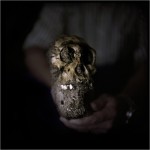Nine-year-old Matthew Berger, son of paleoanthropologist Lee R. Berger, literally stumbled on the skeletal remains of a new hominid species at the Malapa site in South Africa while his father was a hill and a half away looking for hominid bones.
Matthew was chasing after his dog when he tripped on a log and saw something poking out from under a rock. He called out to his father who could tell from feet away that that something was a hominid clavicle. It turned out to belong to a young boy just a few years older than Matthew.
 Dr. Berger and his team excavated the area and found more of the boy’s skeleton, including his excellently-preserved skull, and the remains of 3 other hominids, including a female that may have been the boy’s mother.
Dr. Berger and his team excavated the area and found more of the boy’s skeleton, including his excellently-preserved skull, and the remains of 3 other hominids, including a female that may have been the boy’s mother.
In a report being published Friday in the journal Science, Dr. Berger, 44, and a team of scientists said the fossils from the boy and a woman were a surprising and distinctive mixture of primitive and advanced anatomy and thus qualified as a new species of hominid, the ancestors and other close relatives of humans. It has been named Australopithecus sediba.
The species sediba, which means fountain or wellspring in Sotho, strode upright on long legs, with human-shaped hips and pelvis, but still climbed through trees on apelike arms. It had the small teeth and more modern face of Homo, the genus that includes modern humans, but the relatively primitive feet and “tiny brain” of Australopithecus, Dr. Berger said.
Geologists estimated that the individuals lived 1.78 million to 1.95 million years ago, probably closer to the older date, when australopithecines and early species of Homo were contemporaries.
The bones were all found in a pit within 3 feet of each other. The pit was once part of a cave complex but the roof eroded over the millennia, so the team suspects that the group of hominids either fell into the cave or sought shelter there and couldn’t get out. Their remains do not seem to have been scavenged, so they must have died and been entombed fairly quickly.
There is already a great deal of debate in the scientific community about the classification of these hominids. Dr. Berger’s team thinks they’re descendants of Australopithecus africanus, possibly ancestors of Homo erectus, or a related side branch of hominid not in the direct line of modern human ancestry.
Scientists not involved in the research are debating whether the bones belong to the Homo or Australopithecus genus, but most agree that the discovery of the skeletons at the Malapa site here in the Cradle of Humankind, a World Heritage site where dolomitic limestone caves contain fossils of ancient animals and hominids, is a major advance in the early fossil history of hominids.
“They are a fascinating mosaic of features,” said Rick Potts, director of the Human Origins Program at the Smithsonian. “It reminds us of the combining and recombining of characteristics, the tinkering and experimentation, that go on in evolution.”
Scientists plan to hold a competition among South Africa’s children to find a colloquial name for the boy so people will feel as connected to him as they do to Lucy, the 3.2 million-year-old Australopithecus afarensis found in Ethiopia.